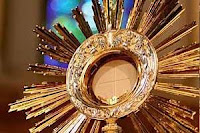
Memorial and Presence in the Eucharistic Body of Christ
By Mark Shea
Before I became Catholic, I was taught in my old Evangelical group that, of course, the Catholic understanding of the Eucharist was so much hocus pocus and that the whole notion of the Host and the Cup actually being the Body and Blood of Christ was a lot of superstitious hooey. So when Paul warned the Corinthians, “Whoever, therefore, eats the bread or drinks the cup of the Lord in an unworthy manner will be guilty of profaning the body and blood of the Lord” (1 Corinthians 11:27), I was taught this referred, not to the Eucharist, but to the Church, the Body of Christ. Whatever you did to the least of the brethren, you did to Christ, etc.
Now, to be sure, Paul is not happy with the Corinthians’ rowdy behavior. The Corinthians were being grade A bozos during their Eucharistic banquets. They were factional, they got drunk, and they routinely humiliated the poorest members of the Body of Christ. But it is also worth noting that absolutely nowhere in Scripture or Tradition is the Church referred to as “the body and blood of Christ”. This is language that plainly refers to what the bread and wine consecrated at the Last Supper and consecrated ever since in memory of him.
In short, Paul warned the Corinthians that to sin against the body of Christ which is the Church is to sin against the body of Christ in the Eucharist. Conversely, to honor the body of Christ which is the Church is to honor the Body of Christ which is the Eucharist. The Eucharist is, for Paul, the beating heart of the Church. Indeed, it was what makes the Church the Church. Without it, we are a group of Christians who happen to pray together in the same room.
The reality that the Eucharist is done “in memory” of Jesus has thrown a lot of Christians out of whack via the process known as “heresy”. “Heresy” doesn’t refer so much to false teaching as to half-true teaching. A heresy fixates on some small aspect of Catholic teaching and declares that it is the only part that matters.
So some Christian traditions have fixated on the memorial aspect of the Eucharist and reduced it simply and solely to a memorial meal, as though Jesus instituted the Eucharist as a (very strong) audio-visual aid to remind us of his passion, death and resurrection. All we are doing, on this theory, is calling to mind the events that happened to Jesus during the Passion, two thousand years ago on the other side of the planet.
On this view, the Eucharist is nothing more or other than a symbol (to which the puckish Flannery O’Connor replied, “If it’s a symbol, then the hell with it.” And, indeed, Christian traditions which have arisen after the reduction of the Eucharist to a mere memorial symbol have said likewise and radically minimized or even abandoned the celebration of communion altogether.
My own church was living proof of this, concluding (quite logically given the premise) that Communion was unnecessary since it was a mere symbol and that truly spiritual people (such as ourselves, of course) did not require such symbols any more than Catholics felt required to engage in footwashing every week.
What nobody knew or told me (till I started to learn about the Church) was that this notion of “memorial” was massively inadequate to the ways the New Testament writers though about the Eucharist. For the word used to describe the sort of memorial it is is “anamnesis”. It doesn’t speak merely of remembering something long ago as we might remember a fond Saturday afternoon in our childhood or a battle or some other historic occurrence in the remote past. Rather, it means a “making present”.
It is the difference between remembering our childhood and remembering where we are right now. Precisely because the Eucharist is truly the body and blood of Christ and not a mere symbol, we remember who Jesus is, what he has done and, most importantly, what he is doing right now in making himself present in our midst.
This “making present” is exactly what is occurring on the altar every time the Eucharist is consecrated. It is the fullest presence of Christ. How can there be “more full” and “less full” presence of Christ. As an analogy, consider the disciples, lurking around in their hidey hole on Easter morning and trying to make head or tail of the burbling of Mary Madgalene after she burst in them with the news from the tomb. While they sat there listening to her and not believing a word of it, Jesus was right there, as present in the room with them as he is with you while you sit reading this. Yet after that, he became even more fully present to them: he appeared to them and they realized that there were different ways in which he could be present.
The same thing happens now. Jesus is present in various ways: in his people, in his word, in the poor and needy and suffering, and in many other ways. But he is fully present in the Eucharist. It is, says Chesterton, the difference between saying “The spirit of God pervades the universe” and saying “Jesus Christ just walked into the room.”
Full Story at National Catholic Register


No comments:
Post a Comment